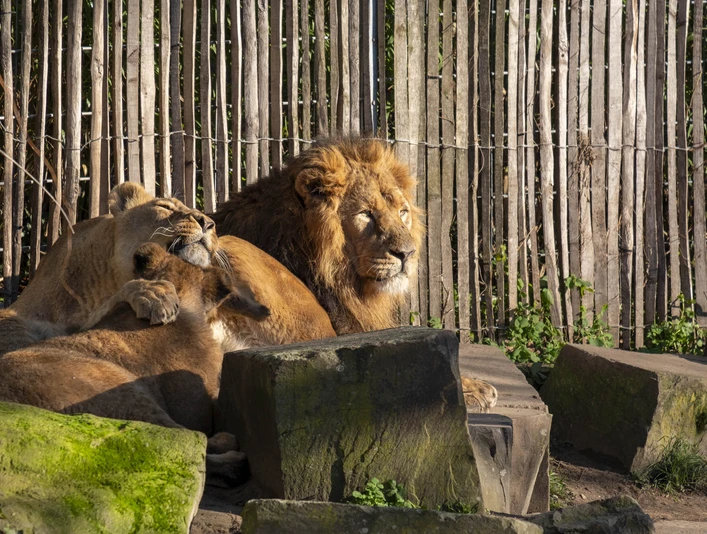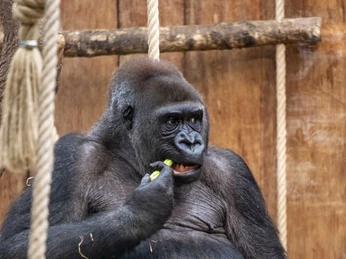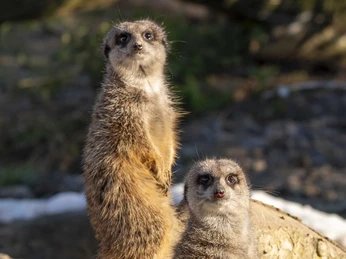- Photos & Map
How would you like to arrive?
- Call
- Website
- Details
- Useful Information
- Nearby
- Plan a visit Booking
What does an elephant need to learn first, despite being born weighing upwards of 75 kg? The proper handling of its trunk! Because it takes a long learning period before it can later lift up to 400 kilos. Acquiring proper control takes up to two years—some little pachyderms even step on their own trunks.
But of course, the Cologne Zoo offers more than just the Elephant Park and its prachyderms to observe and learn about—there are also many other truly amazing things about the animals and plants of our world to discover on a unique day out.
Since its redesign in 2012, the Cologne Zoo has adopted the concept of animal geographic zones: As a visitor, you experience flora and fauna organized by continents.
Around 1980, the Cologne Zoo was in poor financial condition; many structures were dilapidated, and over the years, the zoo was redesigned with the help of the "Friends of the Cologne Zoo e.V." Since 2012, it has transformed into a rewarding adventure world. Today, the Cologne Zoo records over 1 million visitors per year and is among Germany's most-visited attractions.
Natural park landscapes, species-appropriate and well-visible animal keeping, combined with old and modern buildings, create the unique charm of this popular zoo. Bring plenty of time—you can easily spend a whole day at the Cologne Zoo, especially since other attractions are nearby—such as the Flora, the cable car to the Rhine Park, are right next to it.
But of course, the Cologne Zoo offers more than just the Elephant Park and its prachyderms to observe and learn about—there are also many other truly amazing things about the animals and plants of our world to discover on a unique day out.
Cologne Zoo: These adventures await you
Seeing animals all day long—including lunch or snack breaks: A trip to the Cologne Zoo is a special experience, not only with children. If you plan a visit, bring plenty of time, at best a whole day: The zoo is enormous, featuring its own aquarium with a terrarium and insectarium, a modern Hippodrome with hippos and crocodiles, a monkey and elephant house, a baboon rock, enclosures and facilities for cheetahs and other big cats like the rare snow leopard, as well as a large, lovingly designed children's playground. Feeding sessions, which occur daily or weekly depending on the animals, are also exciting.More than 10,000 animals in an educational adventure world
Overall, the Cologne Zoo is home to more than 10,000 cute, dangerous, water-, air-, and earth-loving animal creatures living in species-appropriate and nature-like habitats. Special events, exhibitions, lectures, and activities, which you can view under "Current Events," take place regularly, ensuring that your next visits to the Cologne Zoo remain thrilling.Since its redesign in 2012, the Cologne Zoo has adopted the concept of animal geographic zones: As a visitor, you experience flora and fauna organized by continents.
Highlight: Elephants – 20,000 sqm for Asian pachyderms
Did you know that adult elephants consume about 150 kilos of food a day? Or that they communicate using infrasound—inaudible to us at a frequency between 14 to 24 Hertz—at distances up to 2.5 km? And recognize up to 100 of their kin by voice? Truly fascinating. The Elephant Park has provided space for Asian elephants since 2004, covering 2 hectares. Ten to fifteen elephant cows and separately kept bulls live here in a natural social group—and as a zoo visitor, you're right there. There are indoor and outdoor areas with a water basin and artificial rocks that separate the area for visitors. In 2023, the 13th baby elephant of the Cologne Elephant Park was born.Highlight: Rainforest House – Free-flight hall with birds**
In the Rainforest House, it's humid and warm—you'll notice this immediately upon entry. This is how the creatures in the rainforests of Southeast Asia are used to living. The free-flight hall offers cockatoos, elf-blue birds, helmet hornbills, as well as reticulated pythons, dwarf otters, and many more animals. Warning—don't step on the ground-loving birds you encounter in the corridors.Highlight: Hippodom – Hippos and crocodiles
Stroll through a recreated African river landscape on 3,500 sqm—and look into the eyes of Nile crocodiles through the huge panorama windows. Or watch the hippos perform their underwater swimming movements. You get insights into the life of this African landscape from other perspectives as well—from above or from the side—to see more African animals such as birds, snakes, and reptiles.Highlight: Aquarium – Piranhas, crocodiles and snakes
Animal feedings take place daily at the Cologne Zoo—the feeding of the piranhas in the aquarium, however, does not. These are more frugal—they are fed only on Mondays. Yet, you can observe the most famous inhabitants of the Amazon in their large tank all week. The aquarium at the Cologne Zoo features a building with its own entrance—it houses many other fish species, insects—in the insectarium on the upper floor of the building—as well as snakes, lizards, and Philippine crocodiles. A large reef aquarium shows the vibrant life of the coral reef. The "Rhine Panorama" displays fish species in the various sections of the Rhine River.Arnulf and Elizabeth Reichert House: In the jungle of South America
Sloths hanging above your head and monkeys frolicking in the hall—in the jungle house financed by major donors Reichert, renovated in 2019, you walk over a catwalk to observe animals like howler and capuchin monkeys, Central American armadillos, ocelots, and toucans from the height of the tree levels, experiencing the rainforest as an environment with distinct living strata. The plants grow from the basement upwards.Highlight: Baboon Rock – Quarrelsome and lively monkey theater outdoors
Who ranks highest in the hierarchy and dominates? Settle on one of the many benches around the historic baboon rock of the zoo and watch about 50 hamadryas baboons as they eat, groom, squabble, and play, and determine who has the better card in the mating fight. Things proceed lively for the baboons here, without obstruction or shame—following the concept of fenceless animal keeping, which Hagenbeck first implemented in 1914. Don't worry—a moat separates you from the wild goings-on, the disputes, and the quest to fight for a better place in the hierarchy.Highlight: Jungle House – Gorillas, orangutans and bonobos
Where do animals go when they die? The gorilla Koko, considered the world's smartest animal and appeared on the National Geographic cover, responded with 3 signs from his rich American Sign Language vocabulary of over 1000 signs: "Comfortable – Cave – Goodbye." Besides gorillas, you can watch other primate species living in the Jungle House who are close to us humans in behavior, dreams, and perception of the world. Natural family groups, a vast enclosure—in the Jungle House, you experience our close relatives up close as you wander through a jungle-styled atmosphere. You can observe the great apes both indoors and outdoors in the large outdoor enclosure.Excursion History: Cologne Zoo since 1860
The Cologne Zoo is Germany's third-oldest zoo and was opened on July 22, 1860. Today, visitors can still discover its deep historical roots: at the monkey rock from 1914, the old elephant house from 1863, or the old "South America House" architecturally modeled after a Russian Orthodox church—now renamed the Arnulf and Elizabeth Reichert House—from 1899. The world wars severely affected the zoo. After World War II, it was heavily destroyed and had only 23 animals left. It was able to reopen in 1947 and acquire new animals, including the famous chimpanzee Petermann.Around 1980, the Cologne Zoo was in poor financial condition; many structures were dilapidated, and over the years, the zoo was redesigned with the help of the "Friends of the Cologne Zoo e.V." Since 2012, it has transformed into a rewarding adventure world. Today, the Cologne Zoo records over 1 million visitors per year and is among Germany's most-visited attractions.
Natural park landscapes, species-appropriate and well-visible animal keeping, combined with old and modern buildings, create the unique charm of this popular zoo. Bring plenty of time—you can easily spend a whole day at the Cologne Zoo, especially since other attractions are nearby—such as the Flora, the cable car to the Rhine Park, are right next to it.
Useful Information
Foreign Language
German, English, Dutch
Eligibility
Bad Weather Offer
Suitable for any weather
for Groups
for Class
for families
for individual guests
Suitable for the Elderly
for Children of all Ages
Suitable for Pushchair
for Children of the age of 0-3
for Children of the age of 3-6
for Children of the age of 6-10
for Children of the age of 10 upwards
Openings
Price info
Price adult: €23.00
Price child: €11.00
Price reduced: €17.00
Parking facilities
By bus and tram:
From the main station you can reach the Cologne Zoo by underground line 18 and from Ebertplatz by bus line 140. Stop Zoo/Flora.
By car:
Cologne Zoo is located in the heart of Cologne. Plan your route with the route planner or use your navigation device: Riehler Straße 173, 50735 Cologne.
From the main station you can reach the Cologne Zoo by underground line 18 and from Ebertplatz by bus line 140. Stop Zoo/Flora.
By car:
Cologne Zoo is located in the heart of Cologne. Plan your route with the route planner or use your navigation device: Riehler Straße 173, 50735 Cologne.
General information
Parking Available
Bus stop available
Accessibility
Travel for Everyone
Wheelchairs can be rented at the zoo. Advance reservation is recommended as only a limited number are available.
General Information on Accessibility
Our recommendations
Nearby




